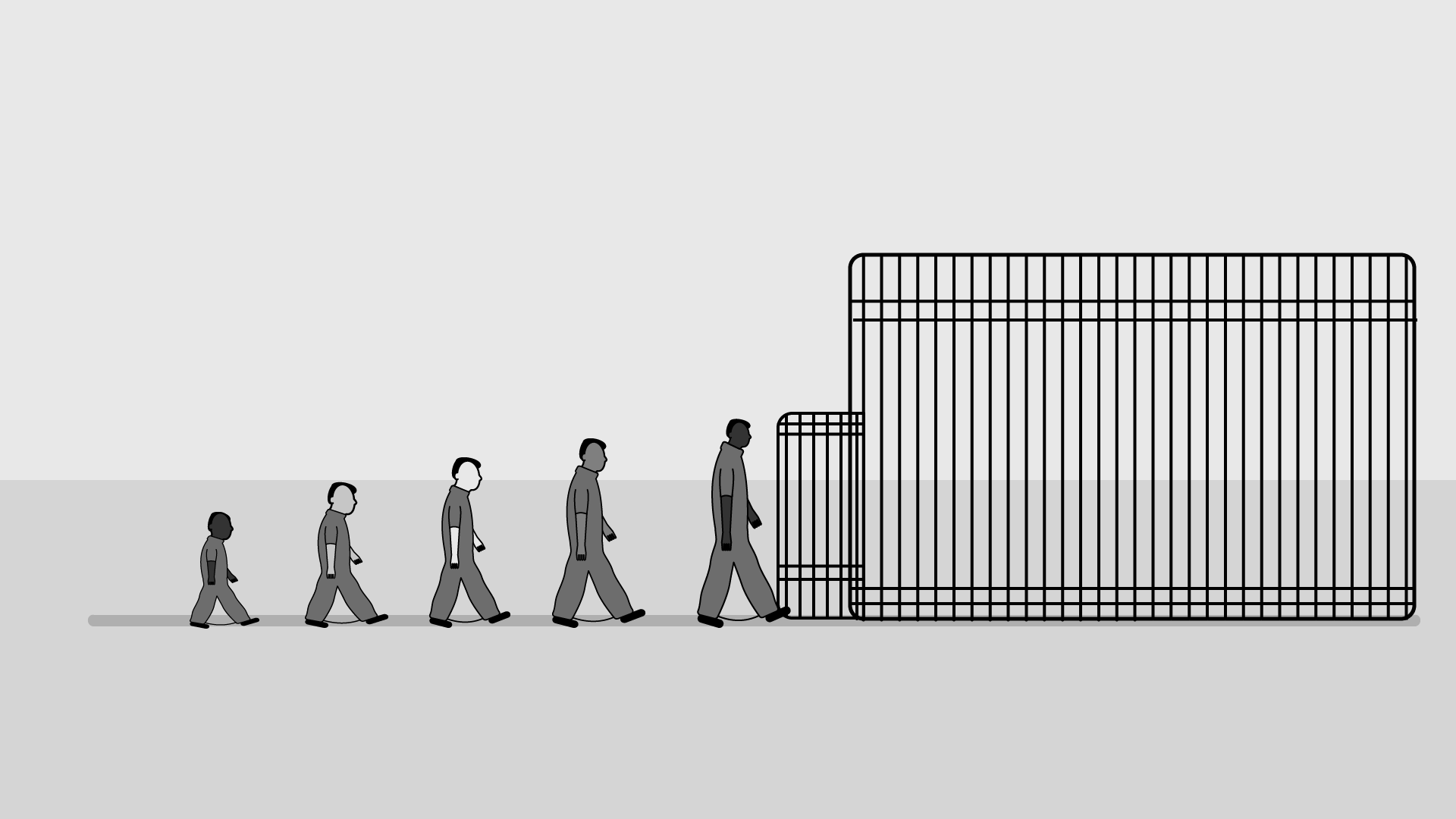
Incarcerated
-
Audio Recording by George Hahn
Regardless of skin color, sexuality, or politics, young men are falling. They are falling behind academically, failing to attach to mates, and trading potential for addiction. Their less-evolved prefrontal cortex is especially susceptible to opportunities for quick dopa hits that have been engineered by firms whose profit incentives are in direct contrast to their economic and emotional well-being. Men make up just 40% of college enrollment and one third of college graduates. They are twice as likely to overdose and 3.5 times more likely to commit suicide than women. Women also face challenges in society, especially in the labor force. However, when we discuss the challenges facing women, we ask society to change. When young men struggle, we ask men to change.
“Young men in America failing,” should be rephrased as “America is failing its young men.” We over discipline, over medicate, and overexpose them to drugs, pornography, and gambling, then blame them for their mistakes. The ways we are failing young men are legion, so let’s focus on one problem: We put too many in prison. 
Locked Up
Two foundational truths re American imprisonment: One, we are the global leader in locking up our own citizens, by a wide margin. We rank ahead of El Salvador, which has the world’s highest homicide rate, and Cuba, an authoritarian regime that imprisons people for “pre-criminal dangerousness.” There are nearly twice as many prisoners in the U.S. as there are lawyers. There are more Americans behind bars than serving in the military or working as full-time cops and firefighters. We have fewer citizens protecting our shores and neighborhoods than neighbors we believe need to be behind bars.
Second, mass imprisonment does not work — it doesn’t reduce crime. Our unrivaled incarceration rate is neither the result of a high number of crimes nor the cause of a low one.
Our intuition tells us that incarceration reduces crime through incapacitation — taking criminals “off the street” prevents them from committing future crimes. However, the actual impact on crime rates is surprisingly small, and, at 2 million Americans in prisons and jails, we are deep into the diminishing returns. A 2014 assessment from the National Resource Council concluded that there was no reliable statistical evidence showing more than modest decreases in crime rate due to increased incapacitation. Simpler evidence? Despite imprisoning people at 10 times the rate of peer countries in Western Europe, we have a similar crime rate.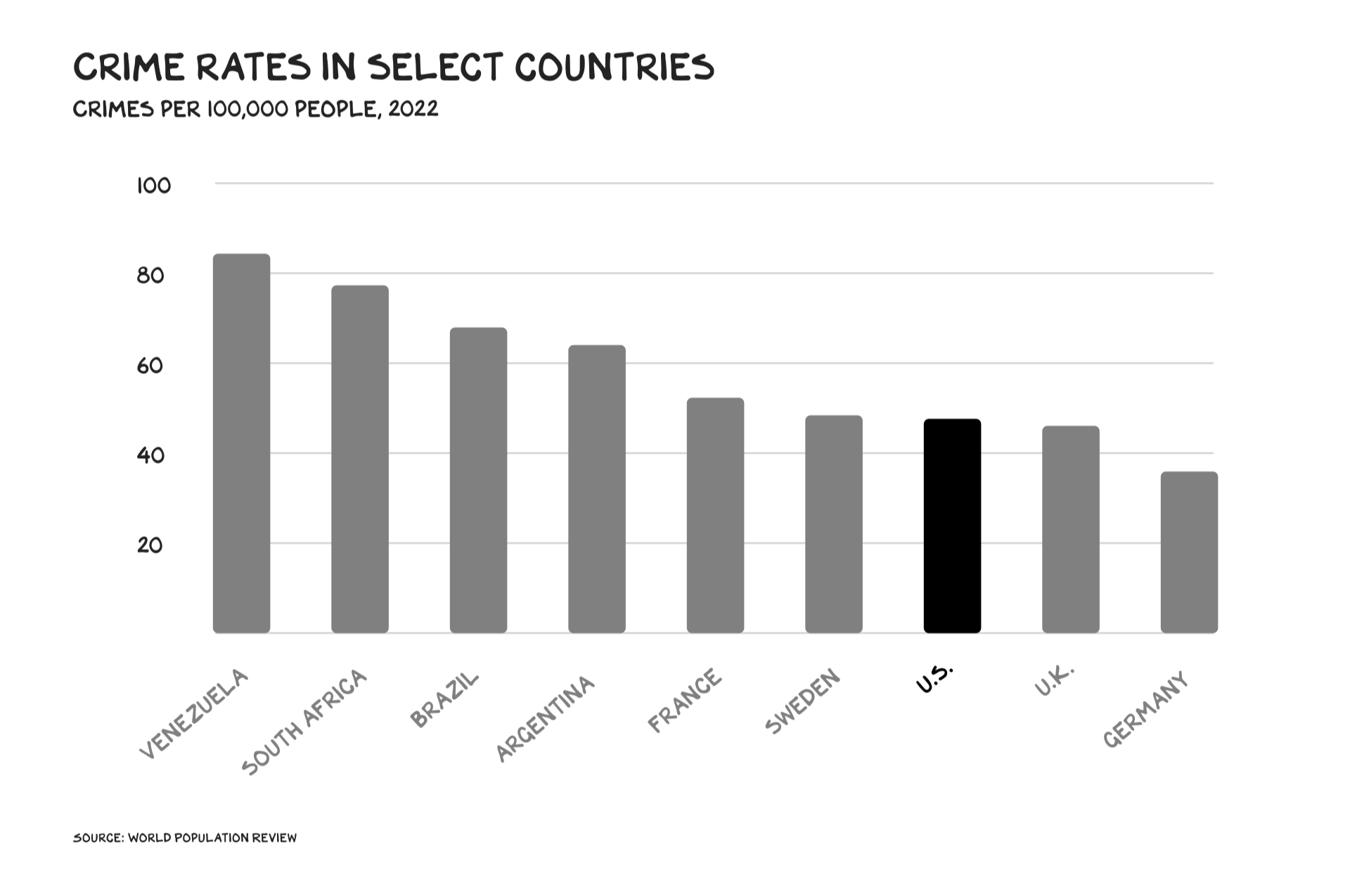
There’s a host of reasons for the limited impact of incapacitation: Many crimes are one-offs; violent crime in particular decreases rapidly with age; and a small minority of criminals commit most crimes. At bottom, though, incapacitation theory rests on a misconception that criminality is a personality flaw, that there are “bad apples” we can remove from the barrel. But most crime flows from circumstance, from failures of socialization, reductions of opportunity, and mental health issues. Poverty and discrimination are crime volcanoes, and you don’t stop the volcano by addressing the lava. Drug-related crimes are particularly resistant to reduction due to incapacitation — drug rings have no trouble finding more disaffected young men to stand on corners.
Identifying and imprisoning high-risk offenders reduces future crime, but warehousing hundreds of thousands of low-level offenders actually increases it. Dozens of studies have shown that imprisonment does not reduce an inmate’s propensity to commit crimes, and there is growing evidence that imprisonment actually encourages future crime — due to decreased legal employment options for those with a record and the exposure to violence and criminality in prison itself. Q: What’s a cause of crime? A: Prison.
We see this at scale. Once the incarceration rate exceeds 325 per 100,000 residents, crime gets worse, not better. Reductions in state prison populations during the early 2000s were associated with reductions in crime rates. Prisoner releases due to Covid were again associated with decreases in crime rates.
Longer prison sentences were sold to voters as a means of “deterrence” — scaring criminals straight. It doesn’t work. Even the Department of Justice (which runs the federal prison system) has emphatically concluded that while the threat of being caught is a deterrent, the length of the resulting prison sentence is not. In 1994, California enacted one of the toughest sentencing laws in the nation, the highly publicized “3 strikes” law, which mandated a 25-year sentence for a third felony conviction. It was sold as a deterrent, a visible, public threat to criminals. Three decades later, it costs Californians over $3 billion per year, but its impact on crime in California has been measured at “negligible” to “small” and “not nearly as large as early projections estimated.”
The War Is Over
If it is ineffective, even counterproductive, why have we locked up 2 million of our citizens? Central to the story is our 40-year “war on drugs” and the deployment of the heavy artillery of law enforcement against the nuanced, human-scale problems of addiction and teenage impulse control. From Nixon, who saw political advantage in criminalizing the minority communities who voted against him, through Clinton, whose own political calculations resulted in the most draconian crime bill in American history, locking up addicts is the definition of political opportunism.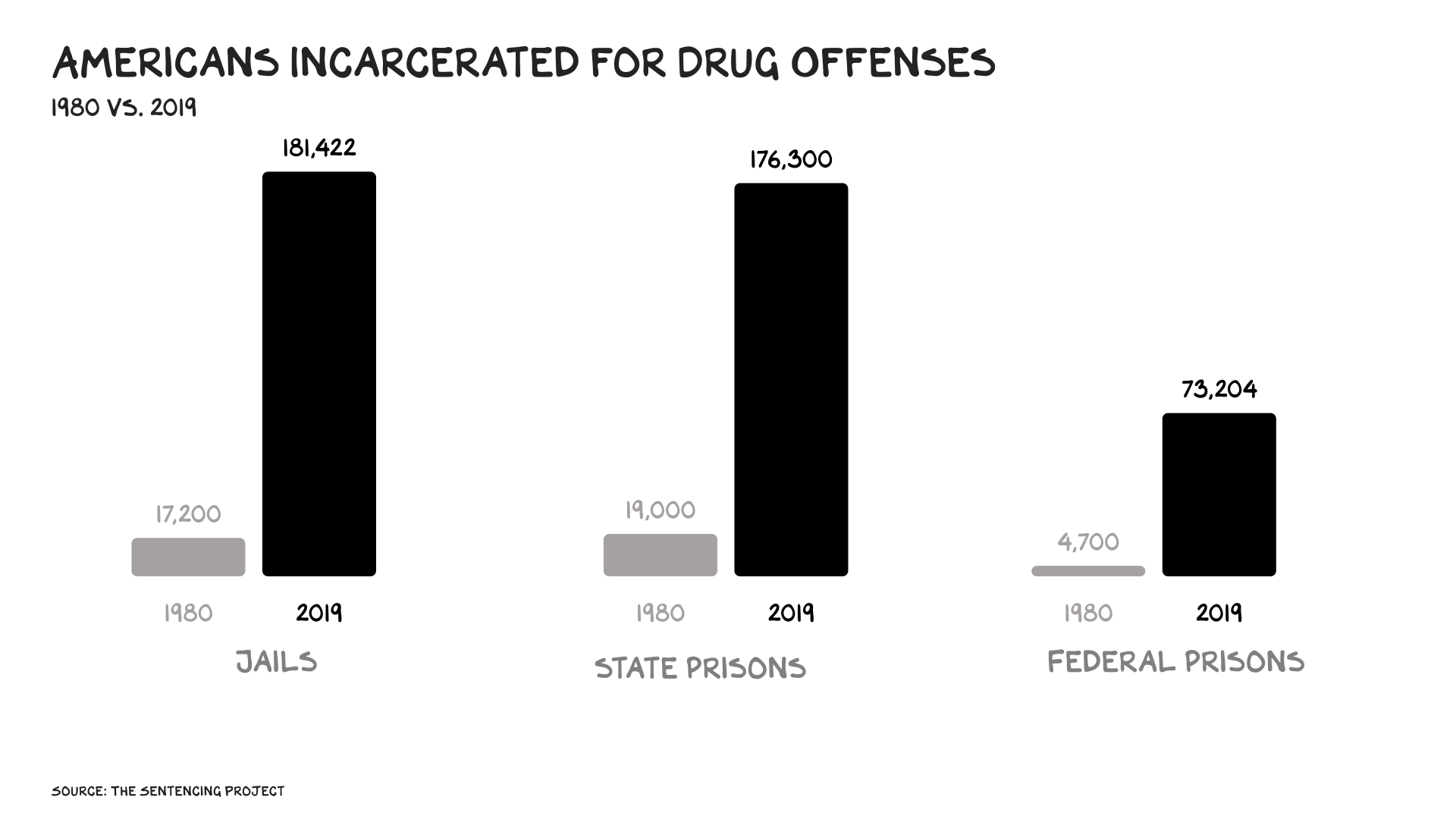
The population of people imprisoned on drug offenses jumped from 40,900 in 1980 to 430,926 in 2019, and the criminalization of addiction has fueled global organized crime empires while hollowing out our own communities. Some more than others.
Although Black and white Americans use drugs at about the same rate, Black Americans are 10 times more likely to be imprisoned for drug offenses than white Americans. One out of every three Black boys born today can expect to go to prison in his lifetime, as can one of every six Latino boys—compared to one of every 17 white boys. And that’s just the domestic burden. Ask the people of Colombia, Bolivia, or Mexico how America’s war on drugs is going. But that’s another post. 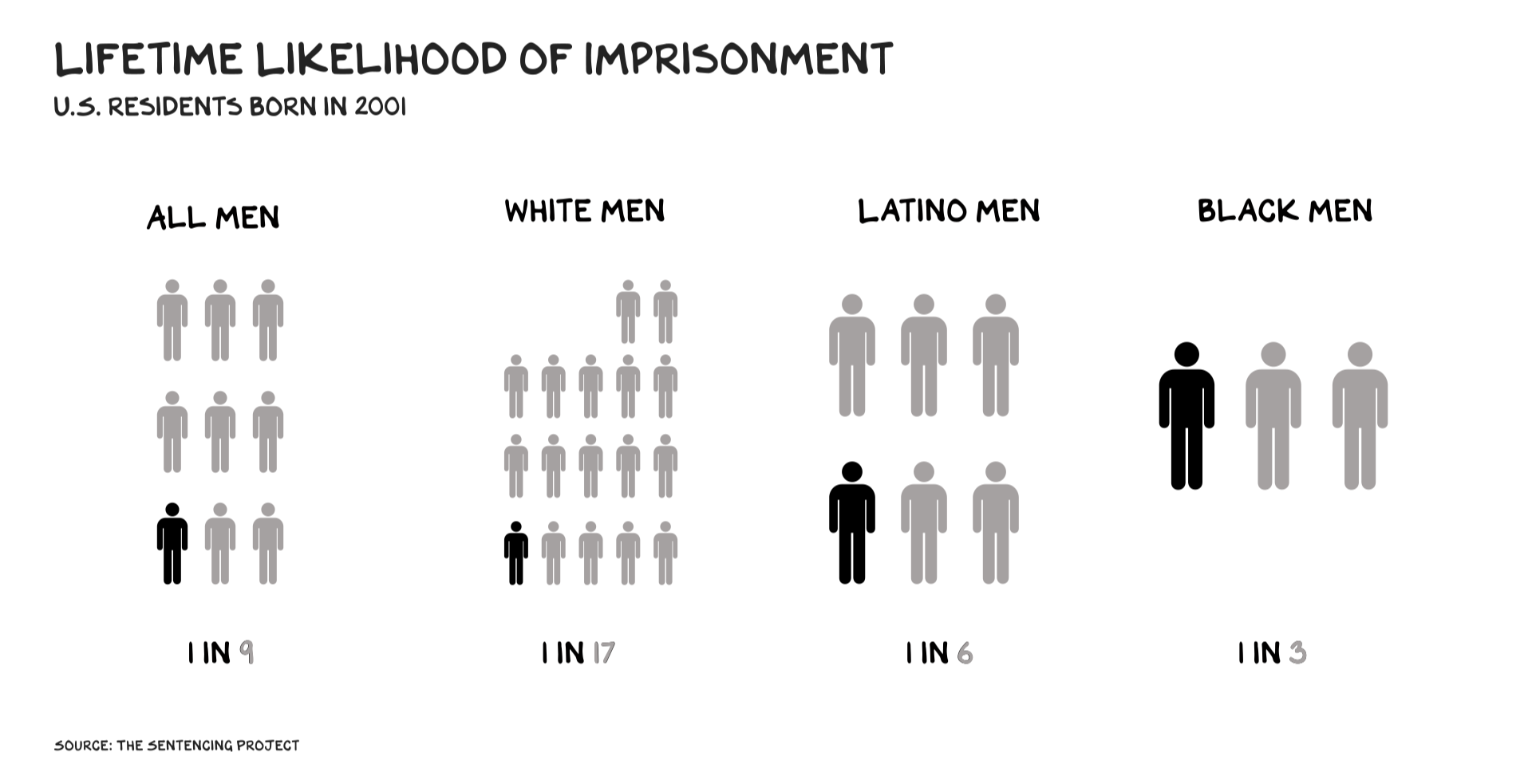
Whatever you think about how we should address poverty and drugs, and who we should hold accountable for the crimes associated with them, there’s another population grievously harmed by mass incarceration that no ideology should be set against: the mentally ill. Sixty years ago, we dismantled our public mental health system. It wasn’t a great system, but our (disastrous) solution was to replace it … with prison. Determining how many inmates have serious mental illness (major affective disorders or schizophrenia) is difficult, but the National Research Council credited estimates of 10 to 25% (versus 1 in 20 among all adults). There are “more than three times the number of seriously mentally ill persons in prisons than in hospitals.”
Defendants with severe mental illness are much more likely to be sentenced to prison. Imprisonment exacerbates mental illness, and mentally ill prisoners are two to three times more likely to attempt suicide. The mentally ill remain incarcerated four to eight times longer than people without mental illnesses arrested for the same charge and cost taxpayers seven times as much. This may be exhibit No. 1 for why American politicians have no license to invoke Jesus Christ when discussing our country. The wealthiest nation in the world incarcerates its most severely ill, its most vulnerable.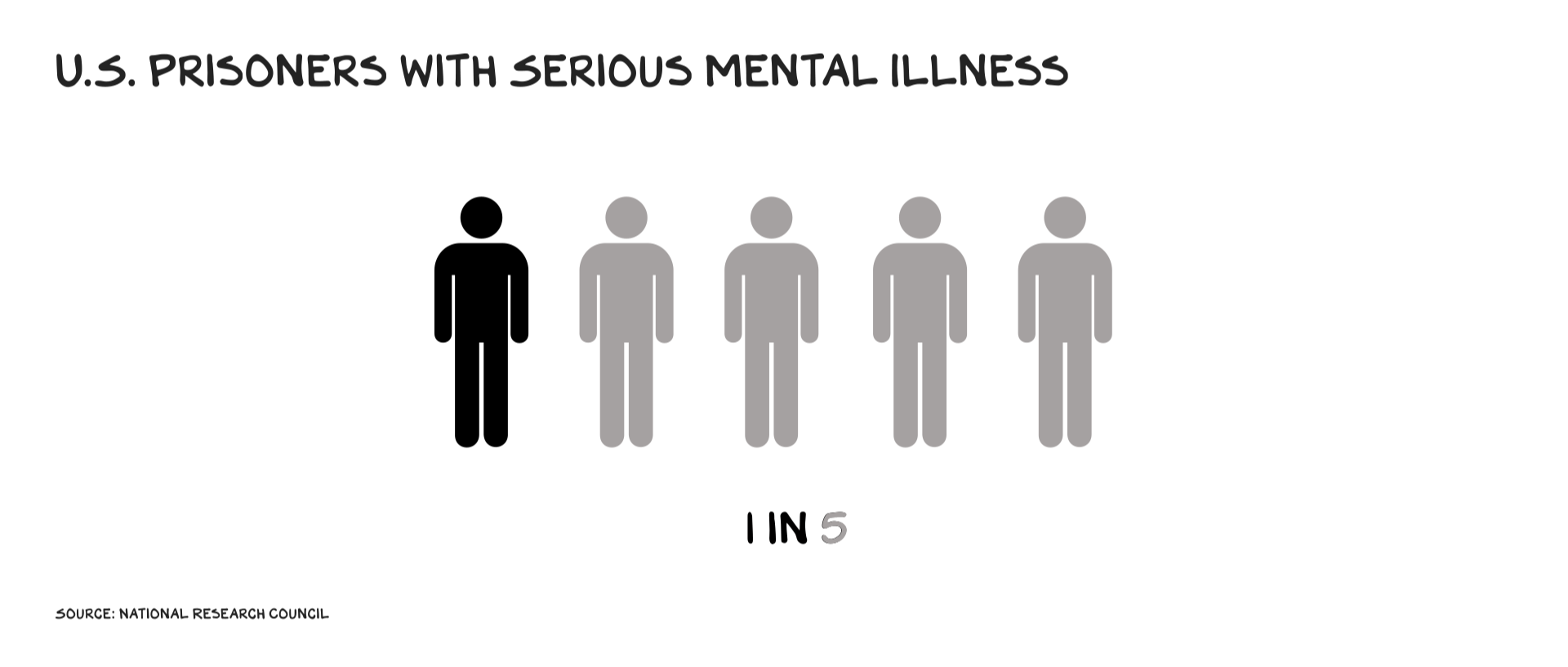
Cui Bono
Every war has its profiteers, and the explosion of incarceration in the U.S. has created an $80 billion industry. $80 billion. We spend more “protecting” Americans from other Americans than most nations spend on defense — including Russia ($63 billion). That’s right, the army thrusting the world to potential armageddon spends less on its armed forces than we spend locking up our citizens.
Eight percent of prisoners aren’t in public institutions but held in private operations run under contract with the state. Many prisons, public and private, look too much like labor camps, where prisoners work not only to run the prison itself (food service, laundry, cleaning) but also for various other state needs (prisoners really do make license plates and also furniture, uniforms, and even law enforcement equipment) for which they are paid less than $4 per day. One company alone, Corizon Health, makes $1.4 billion per year providing prison health insurance (money it needs to fight hundreds of malpractice lawsuits). The prison commissary market is a $1.6 billion annual business, and bail bondsmen generate $2 billion per year. Permitting the market to provide these services provides jobs and increases efficiency, but it is creating an incentive structure at odds with a healthy society. When companies can make billions of dollars on a thing, they get very good at persuading us to create more of that thing. Prison industry companies spend millions of dollars on lobbying and have begun investing in a new growth market: immigration detention.
Left Behind
Mass incarceration has a direct and brutal impact on young men: 93% of prisoners are male, and 41% of adult prisoners are under the age of 35. How prison hampers a young man’s growth is self-evident and not worth dwelling on here. Because there’s a second population of young men we need to discuss.
Roughly half of U.S. prisoners are parents. As soon as a parent steps into prison, their children’s outcomes decline significantly. A child of an incarcerated parent is five times more likely to go to prison. Their cognitive development is stunted, leading to academic failure, and they are more likely to act aggressively in the future.
The impact of having a parent in prison is more pronounced for boys than girls. Studies show that, without a father, boys engage in more delinquent behavior; meanwhile, adolescent girls’ behavior is largely independent of the father’s presence. The increase in aggression due to paternal incarceration is also twice as high in boys than in girls. Boys simply have less emotional resilience than girls, and they’re more vulnerable to stressful situations than girls. Boys are physically stronger, and girls are stronger.
Freedom
To summarize: we have 10 times the number of people in prison than a nation our size and prosperity should. Spending an extra $72 billion a year and keeping an additional 1.8 million people in prison does not make us safer — it might actually increase crime. And it poisons the well for millions of boys who become more likely to end up in prison themselves.
Signs
There have been signs of progress. President Trump signed the bipartisan First Step Act in 2018, a small but significant set of reforms. There are many more opportunities to eliminate harsh sentencing laws, and we should invest in educational and job training programs and pass “clean-slate legislation” to help those leaving prison reenter society. President Biden announced that he’s starting the process to effectively legalize marijuana at the federal level and will simultaneously pardon everyone with a federal conviction for simple possession.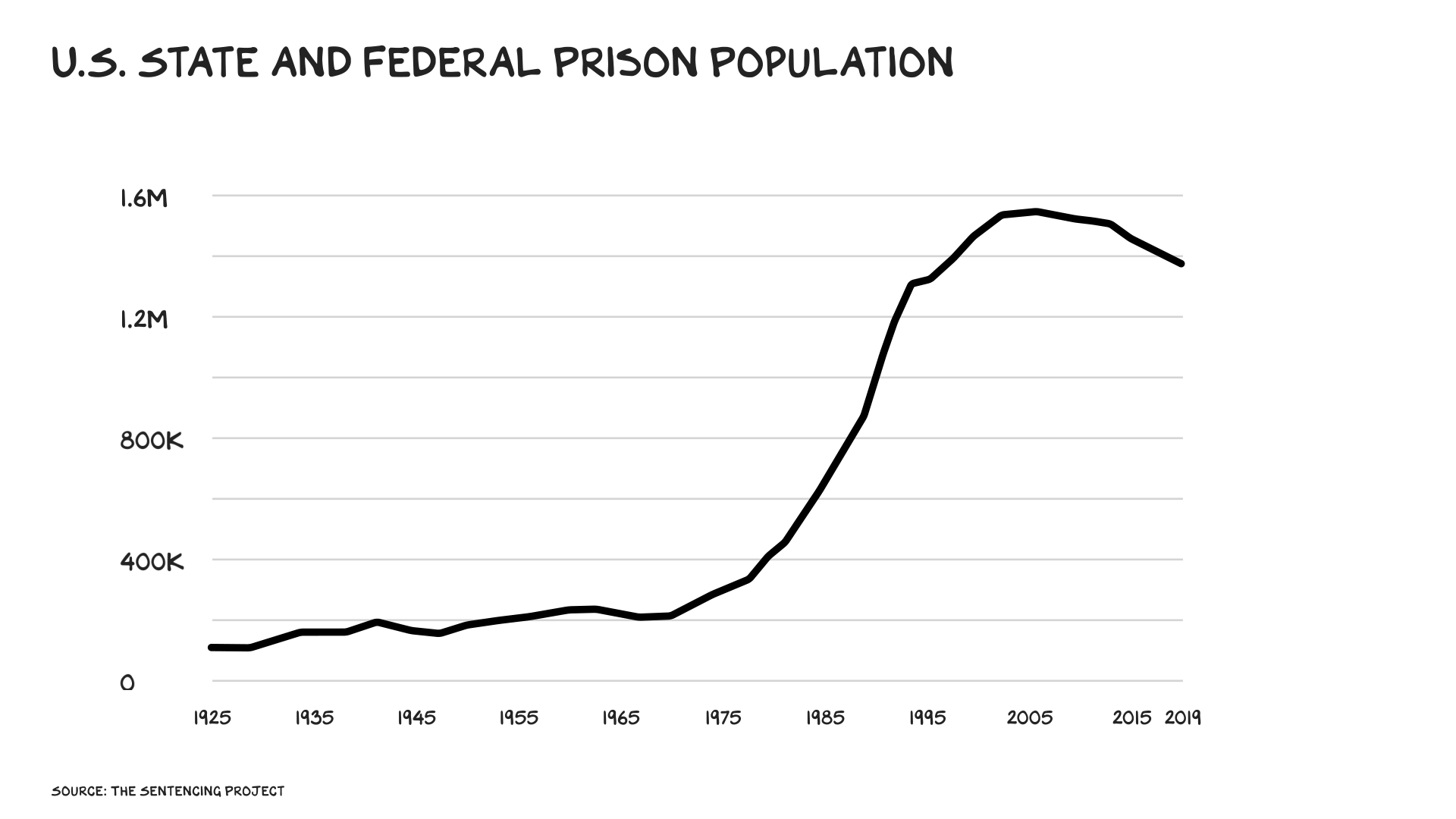
We need to send less people to prison, and start letting people in … out. Diversion programs for drug offenders and the mentally ill are incredibly successful and should be more widespread. Just one example: In Miami, a program to divert mentally ill defendants into treatment rather than jail has cut the county jail population in half, saved taxpayers $50 million per year, and cut recidivism among diverted defendants from 75% to 20%.
Breaking our national addiction to incarceration will require a decade-long, massive prison release program. Which in turn will require a serious investment in true rehabilitation: mental health care, addiction treatment, job training, and re-entry programs. We need fathers (and mothers) back in homes and to stop holding millions hostage for political and financial gain. If we are serious about helping young men, we need to return more men to the community. The incarceration of the populations of Miami, Atlanta, Cincinnati, and Memphis combined has left a void that creates a downward spiral of despair and more incarceration for the boys in that community.
There will no doubt be well-publicized examples of crimes committed by people recently released, and they will skew the perception of the program’s success as crimes not committed can never receive attribution and make for shitty headlines. The illusion of complexity fomented by corporations and incumbents insinuates these problems are multidimensional and intractable. They are half-right. There is a fix that will have an enormous positive impact. Simply put, boys need more men.
Life is so rich,

P.S. Our highest-rated sprint, The Product Positioning Sprint, is running in a few weeks. This one is great for B2B marketers and early-stage startup leaders who are trying to differentiate in a crowded market. Sign up here.


I, by and large, agree with Scott. In this case, his analysis falls far short. He conflates generalized crime data and incarceration data. The US has a violent crime and property crime rate far higher than other nations. A more thoughtful response would be to look at stricter penalties for violent or crimes of violence(e.g. crimes committed with guns, robberies, stealing cars, property crimes) and bypass programs for minor offenses. BTW – US crime rates did in fact decline while incarceration rates increase.
For a another perspective on crime read former attorney general William Barr’s editorial today 10/27 in WSJ.
Everywhere I look we need mental health services funded jumps out at me. Our society is nigh impossible to survive in unaided. Guns, crime, schools, parenting – its everywhere. How long before we get the help we need? Will it come before the effects of climate change disrupt our lives with fires and storms that render life as an emergency, basic needs met only? I certainly dont see it coming after that.
Great post! Both frustrating and heartbreaking. (I was going to make a wise crack about politicians building their careers regarding Kamala H. but I’m just going to let it go for now)
America’s addiction to imprisonment isn’t a problem but a symptom of a problem. It is basically one arm of maintaining the white supremacist patriarchy, much as Fox News is another. You cannot divide and conquer if Black and brown men are allowed to establish families and businesses and to generally live in peace. It’s not rocket science that decimating the Black and brown male population reduces competition for white men. One of the unasked questions is: if the US truly ends the war on drugs and generally stops harassing Black and brown men, what will they do with all the white monsters who presently find a home in “law enforcement”? We don’t want to acknowledge that the kind of people who tried to kidnap Michigan’s governor and who stormed the Capitol are plentiful. Strange which group we incapacitate and which we empower (it’s not that strange).
Great essay. It reminded me a bit of this essay from Samuel Johnson against debtors jails (gaols)
in jolly old England.
https://www.johnsonessays.com/the-idler/cruelty-debtors-prison/
Interesting how we are missing the elephant in the room. Your article gives us glimpses of what that elephant looks like. There are other examples. I enjoyed the Lovett and Dubner (Freakonomics) conclusion that crime rates in NYC dropped as a consequence of Rowe and Wade, and not Guiliani’s draconian hard fisted approach.
Science, people, science.
Agreed and thank you for sharing
Escape from LA and NY seems to become a reality sooner than one would have thought
I think even far-right Republicans agree with this post. Classic virtue-signaling. I would love to see real budget cuts from closing down prisons to pay for the mental health needs. My daughter works at a psych hospital and they have to turn patients away.
This is really sad to read. We all know it’s the truth but we pretend it’s not an issue! Sucks. 🥲
Thorough and accurate article about incarceration. You took a complicated, many-faceted topic and explained it in easy-to-follow language. Thank you.
Excellent article about a desperately sad situation.
A great article. When I was going to graduate school in Sweden 50 years ago, the Swedes had already addressed many of the issues you set forth in your article. Their emphasis is on rehabilitation and they have a low recidivism rate.
In 2018 I went to Sweden as part of a class for my doctorate. We met with a director of a youth center and when we asked him how he got into that work he told use that in the 80’s the ski head movement was gaining ground in Sweden and more youth were being pulled into it as a way of finding belonging. “We had failed out youth by not giving them alternatives that were attractive and meaningful.” So they started the youth center and invested money staffing it and promoting it in the community. They also started a group to help kids exit the skinhead lifestyle and rejoin the mainstream. Hearing this I was struck by how the community had decided to invest in young people rather than punish them and I wish so much we were willing to do the same in the US. But as long as government spending is anathema and low taxes for the wealthy continue, I can’t really see this happening here.
Scott, I wrote a paper in 1998 that included the stat that 85% of the incarcerated have a diagnosed or undiagnosed learning disability. As an educator, I see that how we meet the needs of learners, how we treat each other, how we choose to be in relation to each other; look there. We all are offered opportunities every day to express our integrity. With awareness comes responsibility and the application of will. When we know what to do, based solidly in our integrity, without fear or judgment, we progress– individually and collectively.
You are so right, life is so rich!
If we look back at interviews of many now famous men, we often hear them tell us that they believe their success was their way out of crime. So that opens the question; is that a matter of some form of personal success, that stops decent into crime? Again, I turn to a long ago report about the young men building the Triumph motorcycles, that they ran to work, as their work was so much fun. To “get” a job, work that suited up to then hidden skills, bringing in sufficient income to allow anyone to step out of being dependent on handouts, and into holding their head up in their community . . . is surely the problem solved? If that is correct, then the way out of the dilemma has nothing whatever to do with criminal detention; everything to do with the creation of jobs that pay enough to allow “Fun” into the lives of the majority of young men. Now include into the equation, the overall lack of income being spread back into the communities that have the highest incarceration rates. Work it out, 2 million men NOT earning an income for their families, is likely to be a minimum of some $40 Billion; 10% 200,000 men as high earners will bring that nearer to $60 Billion; so the overall price becomes the incentive for new ways to fund the creation of jobs. Food for thought?
Scott, I so love your posts. I’ve often thought that they’d be even better if there were references to others on any given topic that we could follow up on. For instance with this post, Dr Gabor Mate wrote a phenomenal book on the issue. And when I say phenomenal, I mean phenomenal.
I read that piece by Dr Gabor – very well put together
Bravo sir, a great academic post supported by facts and insight. Well done!
First we have to become a nicer, more caring country… I can already hear the aggressive, accusing cries of “woke!” going out.
I agree with all of Scotts points and have a few to add. There is more to the story than fathers being incarcerated. Out of wedlock single mom pregnancies are crazy high in the same communities that suffer high incarceration rates. Too many men see impregnating women as not their problem. Consequently they abandon their responsibility to the child which we know leads to all kinds of personal and societal problems. How to we get men to own up to their responsibility? Sadly, many in our culture see society as the problem, not the individual, as if they have no agency in their lives. However, once they are in prison, we must do our best to help them get back into society and be able to take care of themselves, their families and contribute to their community.
When we decided that only single mothers deserve help, any family in their right mind split up and Dad moved out. Or Dad never moved in, because a welfare worker may knock on the door. It was the only way to survive. It became entrenched as “the way it is.” Now it is beginning to change (see California). In my lifetime as an educator, I am familiar with many families whose parents did not get married (or even live together) because it would be financially detrimental.
If we quit spending so much on incarcerating our citizens, and those who NEED to immigrate, we would have funds available for all these programs.
It’s the same for disabled people who are on SSI or Social Security. They get much less as a “couple” than as individuals. My husband an I have lived separately for half (at least) or our 40 year marriage because if he earned $50 extra one month then sometime in the future, usually when I least expected it, they took $25 out of my check. He worked irregular hours so his income varied a lot each month so, at the end of the year, either they owed me a few hundred dollars – or I owed them money that they took out of my checks in the future.
So my husband and I had to split up. When I told Social Security that I was moving back in with him I lost my SSI completely! Along MediCal. Because he made “too much money” even though his income still put us well into our county’s poverty level. It caused a real hardship for him – suddenly having to feed, clothe and pay medical expenses for another person. Especially one who had no income and couldn’t work for more than a few weeks without having an episode!
So it’s not just a single mother issue. It’s a widespread government problem.
The new woke/left politicians have responded to Scotts call. We see early release and no-bail releases as NORMAL now in urban areas. According to WSJ, 84% of FELONY Domestic Violence perp in SF released within 48 hours. In response, gun purchases by women has skyrocketed. How do you thing THAT helps crime stats? Soros funded DAs have let ’em go in LA, SF, NYC, and Chicago. Show resolve for law enforcement and jail time, and the citizens will respond in kind. No punishment means more crime, but of course you get you smaller incarceration wish. Which is it?
c cook. I feel you missed the overall point and underlying fundamentals of this post. Having said that, what you’re mentioning is way down the line, as it were. Galloway is looking at the root. Some of what you say is true, as I have friends who are judges and their hands are tied and they are frustrated. Also, name calling almost always discounts the point or points which follow. Be Well !
Under the banner of compassion we close our mental health institutions and replaced them with a choice of prison or living on the street like a stray dog.
Mental health institutions are expensive, so most on the Right don’t want to fund it, and the Left feigns at the idea of further institutionalizing anyone. The result is these very seriously mentally ill people are literally left out in the cold.
The reality is that “solution” is not cheaper nor is it compassionate. What it is, is a national embarrassment and a disgrace.
Closing down of many State Hospitals in California was on the hands of the DNC Legislature. Remember ‘One Flew Over The Cockoos Nest’ movie? The movie caused an uproar and the left was convinced we were holding ‘just folks’ in hospitals. DNC pushed to release them. Legislature did.
O’Connor v. Donaldson changed everything across the US. “Cuckoo’s Nest” certainly didn’t help.
c cook. Actually, the downfall started with Cal Gov Ronald Reagan signing the Lanterman-Petris-Short (LPS) Act, a bi-partisan bill, SB 677. From there came mental hospitals discharging patients, shutting down and the privatization of boarding houses that were for profit — money based on head count and not standard of care or success in treating th patients. It was…and still is.. a boondoggle to make money.
I have this technique not to go to prison, it’s called not committing crime. The notion the USA has a perverse system to incarcerate young men has no empirical evidence. i.e. Black men age 18-32 commit 68% of all violent crime according to national crime stats and only make up 5-6% of US population (13% black – account for elderly, young, women). To blame this on the system is saving people out of the river without finding out why they’re falling in upstream. Can we just admit a culture can be decadent without blaming it on another race? Odd, the proclivity of the Asian community (minorities) not to commit crime never comes up in such discussion.
Well stated Candace…this is a cultural problem not a racial or prison problem. If Prof Galloway’s solution were ever implemented, I guarantee it would be done ass-backwards…1st they’d release the criminals, then 2nd they’d start trying to social engineer 2 parent families, fix education, etc which they will never resolve in today’s woke world. If you think the price of locking-up criminals is high, wait till you see the price on not locking them up !!!
https://detester.org/publications/162kennedy
It must be fun making up racist statistics on the Internet.
This was enlightening for me and has changed my thinking on this subject. It seems like a chicken and egg problem though. You can’t let everyone out of jail until you have the support systems in place to make sure they do not return. Take the example of the McDonald’s hatchet man who committed another crime. How do we protect people against his acts without detaining him in some manner?
Thank you, Scott. I am hopeful that we can reverse this shameful trend with common sense, facts, and compassion. My brother was incarcerated in 1997; he was given 97 years (3 strikes) for stealing less than $600. He is still there and if ever released will become my dependent at 65yrs of age. The story is sickening. I have always said that it will come down to money. I see small glimmers of hope here and there, but it is still so much worse than most people take the time to realize.
I agree, boys need more men. Boys need leadership, structure and discipline. There’s a lot at work here, disparity is NOT proof of discrimination. 85% of all youths sitting in prisons grew up in a fatherless home. I firmly believe the issue is NOT rooted in race and it starts with having 2 parents in the home. But there should be areas where there is no disagreement. You can’t disagree about whether corruption and criminals should go unpunished.
This. Single motherhood rate is >70% in the black community. Black men age 18-32 commit 68% of all violent crime according to national crime stats and only make up 5-6% of US population (13% black – account for elderly, young, women). You can’t say it’s a culture issue without being labeled as a ‘racist’ by the Left. Children need fathers as much as they do mothers. It amazes me a society so quick to point out a woman with “daddy issues” doesn’t put any emphasis on fatherhood.
The prison industrial complex is a national disgrace. So many people make money from this system (judges, prosecutors, defense attorneys, police, guards, prison owners, prison vendors, bail bondsmen, and on and on) that it will be difficult to change. The incentives are completely misplaced. Prosecutors look for “wins” instead of justice and convict everyone they can and then boast of their conviction record. They abuse the plea bargain system, where they hold all the cards, to force innocent people to knuckle under to their demands or face a much worse fate. The plea bargain system is institutionalized blackmail. Then the fact that this country actually imprisons people for merely possessing drugs while wealthy people have wine cellars with enough alcohol to sedate a large city is disgusting. Then you have judges who in some states are elected rather than appointed (a terrible concept) and are more focused on how tough on crime they can claim to be in the next election versus doing the right and honorable thing. It is in some ways a vast conspiracy to destroy lives and families for fun and profit. Thank God for the Innocence Project but they can only fix a tiny percentage of the millions of unwarranted prison sentences. I recommend “Smoke But No Fire” by Jessica Henry for a look at the incalculable failings and distortions in our criminal justice system.
I always appreciate research written in a manner that the average person can understand especially coming from an academic. That said, I give annually to the Innocence Project because there’s nothing I can do to prevent the problem you outlined. Changing what people believe is true that isn’t is extremely difficult.
Great post, Scott. So much truth. The question is, if it took us forty years to get to this place, how long will it take to steer the ship back on course? It all depends on the actions of legislation?? I really appreciate the fact you use your voice, and your panache, to bring attention to those underserved. For a reluctant contrarian, your message/messages give me hope for our future and our ability to consider the well-being of others. Thank you for that!
I am writing a paper on this very issue. In my research, I am referred back to 1984 when the private prison industry really found its footing. I am learning that the private prison industry is responsible, below the radar, for much of the population proliferation. Think about the incentives associated with it. The profits are driven by only on factor, that being population growth. Now, think about how that can be maniupated and corrupted over time. The private prison industry needs to be eradicated, as soon as possible. It is as evil as illegal drug trafficking. In fact, they may be dependent on each other. Drug trafficking inside prison facilities is a thriving business. Eradicating private prisons is not the total solution, but a strong step in the right direction.
Kent please let us know how we can read your paper when it is completed. Thank You.
Cui bono? Weak men leads to a weak society that is easily ruled through fear. You are right to call out the problem, yet you continue to support a party that attacks men – particularly white men. You can’t reason with a demoralized person.
We have far too many prosecutors!
Wow 👏🏻 👏🏻 👏🏻
Not necessarily convinced that ‘girls are stronger’ although it is definitely a consideration. The same sex parent is better for the child in terms of leadership, mentorship, self-concept, etc. If the father is removed, it will naturally impact the son more than the daughter, and I believe the reverse obtains. Either way, if there are billions being made and political expedience to be derived from incarceration, well, not looking for change any time soon.
It’s clear that our prison system is providing neither deterrence nor rehabilitation. Unfortunately, our legal system has come down against any sort of compulsion in treatment of mental illness or drug addiction. Further, despite our burgeoning incarcerated population (or perhaps because of the expense of it) low level offenders are routinely either ignored or quickly back on the streets. It’s no secret that they make up a significant portion of the “homeless” . Until these “resistant” populations are subject to compulsory treatment you can expect more of the same. It will cost money, and the ACLU will howl that their clients are being deprived of their “rights” and “freedom”.
Really important article–Thanks for contributing to this critical conversation. Collateral consequences are real and too few programs available to address them. We’re trying to help at BC Law School: http://lawmagazine.bc.edu/2021/01/no-holds-barred/
Wow. This has a very strange flavor to it. Many of your facts are flat out wrong. Other are tendentious or one-sided. Your sources are largely advocacy groups, not real scholarship. You’ve conveniently ignored the murder rate as an index of crime. Weird. I assume because it is inconvenient for your thesis. Most criminologists consider murder the most reliable, and for obvious reasons, the most important index of crime. The United States murder rate is exponentially higher than Europe’s. Any thoughts on that?
No one likes mass incarceration, and criminal justice reform is overdue, especially for drug offenses. But the claim that incarceration has no link to crime is simply false.
Here is a more balanced perspective from an actual criminologist:
https://www.city-journal.org/mass-incarceration-hysteria
Great article Scott. I could not agree more with you. Time is way overdue to decriminalize illegal drugs, taxing them heavily to boost early education and prevention programs across the US.
In America you don’t have to be a criminal to be locked up
Just get married theregavd a kid lose your job through no fault ov your own anc you can see what jail is.
What an broken system that puts profits over justice.
I have 4 daughters but my son will never get married there.
Young men are the target of this agenda I believe it’s part of a population reduction system.We are currently experiencing.